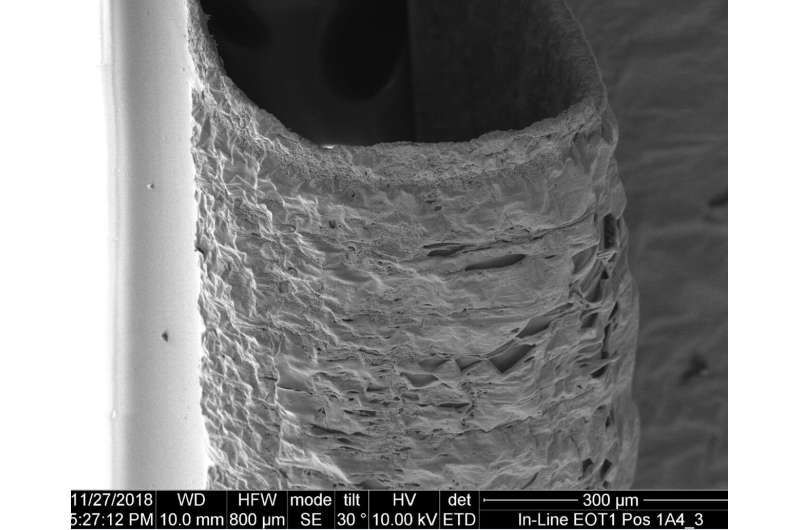This article has been reviewed according to Science X's editorial process and policies. Editors have highlighted the following attributes while ensuring the content's credibility:
fact-checked
trusted source
proofread
Juice mission to Jupiter testing—down to the wire

Preparing the Juice mission to Jupiter has involved testing for all kinds of contingencies, down to the smallest of scales. This microscopic view shows surface damage to a tiny silver interconnector after being exposed to erosive atomic oxygen known to be found surrounding Jupiter's moon Ganymede.
Due to launch on April 13 to begin an eight-year journey to the largest planet in the solar system, ESA's Jupiter Icy Moons Explorer, Juice, will spend three and a half years in the Jupiter system, and in the final phase of its exploration will go into orbit around the largest Jovian moon, Ganymede.
However, previous observations by the Hubble Space Telescope have revealed auroral glows around Ganymede due to the presence of 'atomic oxygen'—individual atoms of oxygen at the fringes of the moon's scanty atmosphere, the result of standard oxygen molecules being broken apart by the powerful radiation belts surrounding Jupiter.
ESA materials engineer Adrian Tighe explains, "Atomic oxygen is also experienced in Earth orbit, due to oxygen molecules being dissociated by ultraviolet radiation from the Sun, and all Earth-orbiting missions below about 1000 km altitude are designed to resist it. In the same way, the Juice team needed to know that susceptible materials could withstand the atomic oxygen the spacecraft would encounter in the mission's Ganymede elliptical orbit phase."
This test focused on silver interconnects used in the Juice solar arrays—connectors just a few tenths of a thousandth of a millimeter thick—looking into their susceptibility to atomic oxygen exposure combined with low-temperature 'thermal cycling'—repeated rapid temperature shifts. Of particular concern was the risk of microcracks forming in the silver, which might lead to failure.
"Silver is one of the very few metals susceptible to atomic oxygen erosion," comments Sam Verstaen of ESA's Juice team. "But silver was also the preferred metal for these Juice interconnects in order to maintain the spacecraft's magnetic cleanliness which is essential for the optimal operation of our suite of in-situ science instruments."
Testing was performed in the Low Earth Orbit Facility, LEOX, of ESA's Materials and Electrical Components Laboratory, part of the Agency's ESTEC technical center in the Netherlands.
A one-of-a-kind facility in Europe, LEOX uses a laser to dissociate molecular oxygen into atomic oxygen at energy levels that are equivalent to orbital speed—7.8 km/s—to simulate the space environment as closely as possible.
"The general effects of atomic oxygen exposure could be seen clearly on the sample interconnectors," adds ESA materials engineer Gabor Milassin, who performed the testing. "However it was demonstrated that this was only a surface effect, and no major cracks were observed which could compromise the functionality of the interconnects—the silver interconnects could be given a clean bill of health to go to Ganymede."
The lab also worked on numerous other Juice-related tests, including evaluating multi-layer insulation, adhesive tapes and thermal control coatings. Juice presented particular problems in materials terms because the mission will pass from the high-temperature environment of a Venus flyby, where temperatures will rise above 200°C, down to a much colder environment around Jupiter.
Provided by European Space Agency





















